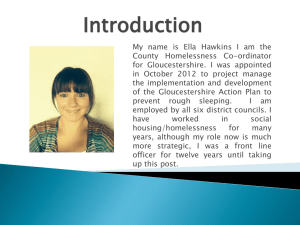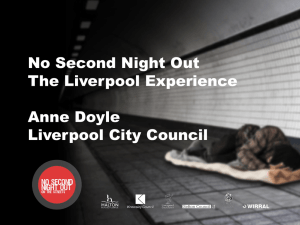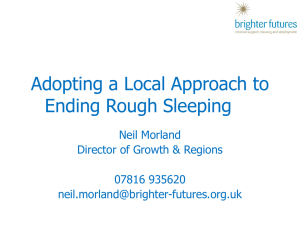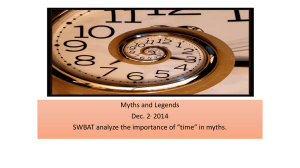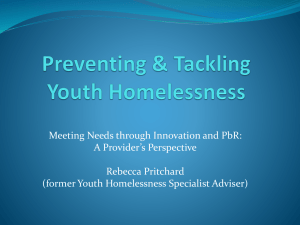Health Care Needs of Roughsleeping
advertisement
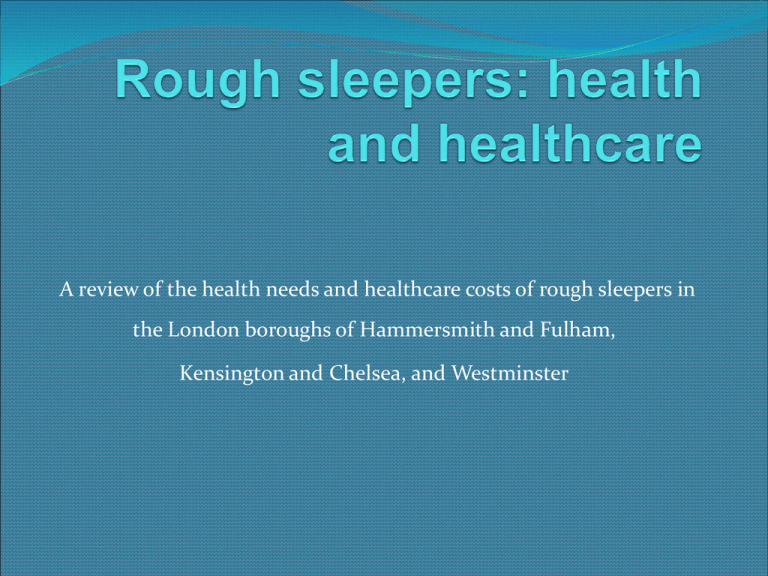
A review of the health needs and healthcare costs of rough sleepers in the London boroughs of Hammersmith and Fulham, Kensington and Chelsea, and Westminster Rough sleepers needs assessment The review includes three work streams: Literature review - to set the scene, understand the health needs, and identify interventions to support rough sleepers Qualitative research - interviews to understand the barriers to healthcare (undertaken by Broadway) Analysis of hospital data to understand the healthcare utilisation Setting the scene (literature review) • Health needs – most common are alcohol or drug dependence, mental illness, and dual diagnosis. Homelessness is associated with tri-morbidity • Service use – greater use of A&E and hospital services than general population. Rough sleepers face a range of barriers to accessing services • Costs - homeless people consume about 4 times more acute hospital services than the general population, costing £85m. Very little cost effectiveness research – although some economic evidence for intermediate care • Effectiveness of interventions - overall lack of good quality research, although some evidence for case management for mental health and substance misuse, and that housing should be provided as part of integrated model. • Models of service delivery - models of care range from mainstream practices providing homeless services to fully coordinated primary and secondary care. Discharge planning should be a component of an integrated model to prevent inappropriate discharge back on to the streets and reduce emergency readmissions Reducing barriers to accessing healthcare (qualitative research) As identified in the qualitative study, there are examples of practice which could enhance access to health services and improve health outcomes: health services removing barriers to access and enhancing patient experiences using homelessness support services to enhance access to health services taking services to where homeless people are services coming together to improve joint working Examples to support access to health services (qualitative research) Enabling access Specialist homeless GPs GPs registering people without the need for proof of identity Local accommodation projects which have a health focus Accompaniment to appointments, eg Groundswell peer health advocates Open referral system to secondary healthcare, eg UCL Pathway team Bringing services to the patient Day centres where health services are brought in Outreach e.g. outreach team that are accompanied by a mental health social worker and in nurses from GP practices going out with the homeless outreach teams Hostel in-reach One stop shops, eg a supported accommodation projects offering regular ‘health MOT’ sessions Working across service and organisational boundaries Find and treat tuberculosis services Dual diagnosis outreach worker Discharge from hospital (qualitative research) Concerns include: Early discharge before patient feels health needs have been fully met. Discharge to the street either because homelessness is not identified or hospital staff do not make the necessary referrals following the disclosure of homelessness. Poor communication between service providers upon discharge. Discharge without clothing or transport. Suggested improvements: The provision of respite accommodation with adequate healthcare. A system of care coordination for every homeless person to ensure that all their health and social care needs have been fully addressed Analysis of hospital data 3450 individuals confirmed to be rough sleepers was identified from the CHAIN (Combined Homelessness and Information Network) system and matched with NHS general practice registered data. Those rough sleepers from CHAIN were identified between January 2010 and December 2011. 933 patients had NHS numbers within Health services data. For those rough sleepers: High proportion of 30-59 age population compared with INWL general population Common countries of birth: UK (49%), Poland (12%), Ireland (4%), Lithuania (4%), Romania (3%), Portugal (2%), Rest from 76 other countries More than half of rough sleepers had contacts with a hospital Out of 933 patients that registered with a GP practice in INWL GP practice 555 patients had contacts with acute NHS hospital. Nearly 40% of rough sleepers attended all three types of hospital services (A&E, outpatients and inpatients) Hospital Activity ratios for rough sleepers, compared with INWL general population Rough sleepers have significantly high hospital activities compared with general population Total cost of services for rough sleeping population, split by hospital service per year Excess hospital cost of rough sleeping per year = (real cost of rough sleeping per year – Estimated cost for 933 patients from Inner North West London with same age and gender Rough sleepers have high rates of did not attends (DNA) to hospitals One Westminster based GP said: ‘We need to be as concerned with the people who do not attend the service as the people who do, cause often the ones who are not attending us have the greater need.’ Accumulative cost of hospital care (£) 10% of rough sleepers contribute to 50% of health care cost £2,400,000 £2,200,000 £2,000,000 £1,800,000 £1,600,000 £1,400,000 £1,200,000 £1,000,000 £800,000 £600,000 £400,000 £200,000 £0 0 5 10 15 20 25 30 35 40 45 50 55 60 65 70 75 80 85 90 95 100 Percentage of rough sleepers accessing hospitals Other findings (data analysis) Increase in trends in hospital activity: 2 fold increase in rate of hospital activity from 2010 Jan- 2011 Dec to 2012 Jan- 2012 June period. Outpatient activity: Rough sleepers have high number of attendance due to mental illnesses, trauma & orthopaedics and alcohol related attendance Inpatient activity: Rough sleepers have significantly high emergency rates while low rates elective admissions compared with general population. Inpatient activity: Main diagnosis for admissions for rough sleepers are mental illnesses, injuries, poisoning, alcohol related problems and musculoskeletal problems. Number of rough sleepers in Westminster by ward location of GP practice Ward location of GP practice St James's West End Warwick Westbourne Harrow Road Vincent Square Church Street Little Venice Maida Vale Queen's Park Marylebone High Street Churchill Hyde Park Knightsbridge and Belgravia Tachbrook Abbey Road Bayswater Lancaster Gate Bryanston and Dorset Square Regent's Park Number of rough sleepers 312 59 40 36 26 25 18 13 11 9 8 7 6 5 5 <5 <5 <5 <5 <5 Final Summary Hospital utilisation and hospital cost for rough sleepers are significantly higher than the tri-borough general population Rough sleepers have a high proportion of co-morbidities and a high frequency of attendances/ admissions. A small sub group of rough sleepers have a particularly high level of need - 10% of the rough sleepers accessing hospital services consume approximately 50% of the total cost of hospital services Commonest diseases for these rough sleepers are Mental illnesses, Alcohol related diseases, Trauma & Orthopaedics. Rough sleepers have high rates of DNA (did not attends) Access to healthcare is problematic and rough sleepers face many barriers e.g. GP registration Integrated model of service delivery needs to ensure access to a package of care which links health, social care, housing, and voluntary sector provided ser vices. Discharge planning following a hospital admission requires joint working and an agreed process. Next Steps Central London CCG programme of work: - Targeted health promotion with ‘Groundswell’: peer advocacy to support the highest users of secondary care - Nurse outreach service - Community hepatitis C treatment service Commissioning cycle

